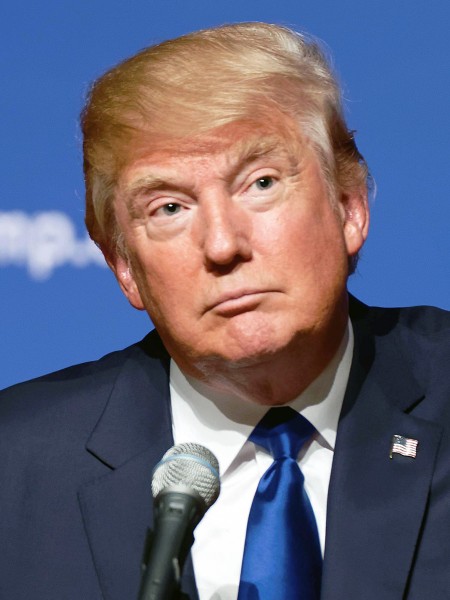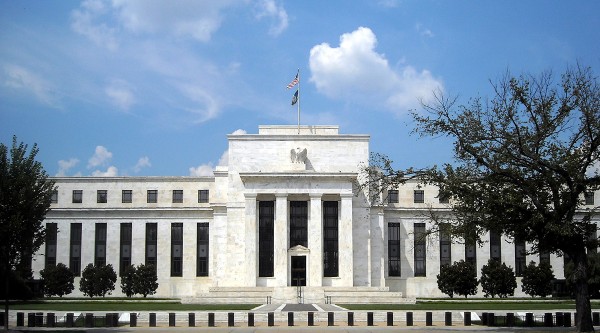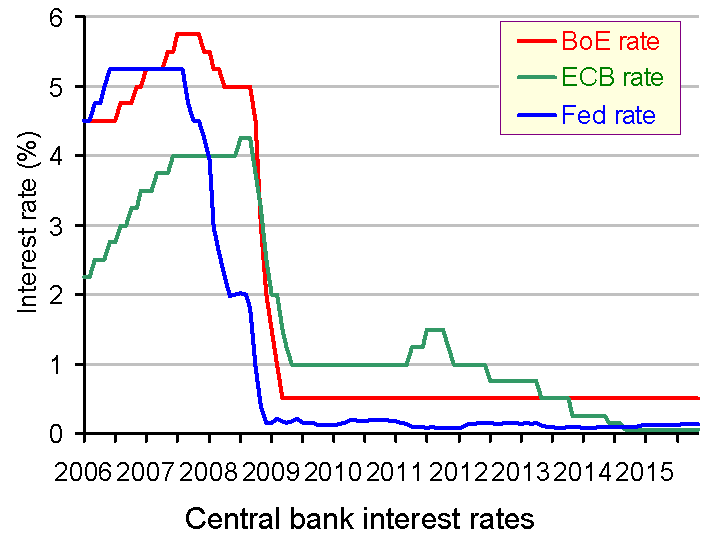 On 14 December, the US Federal Reserve announced that its 10-person Federal Open Market Committee (FOMC) had unanimously decided to raise the Fed’s benchmark interest rate by 25 basis points to a range of between 0.5% and 0.75%. This is the first rise since this time last year, which was the first rise for nearly 10 years.
On 14 December, the US Federal Reserve announced that its 10-person Federal Open Market Committee (FOMC) had unanimously decided to raise the Fed’s benchmark interest rate by 25 basis points to a range of between 0.5% and 0.75%. This is the first rise since this time last year, which was the first rise for nearly 10 years.
The reasons for the rise are two-fold. The first is that the US economy continues to grow quite strongly, with unemployment edging downwards and confidence edging upwards. Although the rate of inflation is currently still below the 2% target, the FOMC expects inflation to rise to the target by 2018, even with the rate rise. As the Fed’s press release states:
Inflation is expected to rise to 2% over the medium term as the transitory effects of past declines in energy and import prices dissipate and the labor market strengthens further.
The second reason for the rate rise is the possible fiscal policy stance of the new Trump administration.  If, as expected, the new president adopts an expansionary fiscal policy, with tax cuts and increased government spending on infrastructure projects, this will stimulate the economy and put upward pressure on inflation. It could also mean that the Fed will raise interest rates again more quickly. Indeed, the FOMC indicated that it expects three rate rises in 2017 rather than the two it predicted in September.
If, as expected, the new president adopts an expansionary fiscal policy, with tax cuts and increased government spending on infrastructure projects, this will stimulate the economy and put upward pressure on inflation. It could also mean that the Fed will raise interest rates again more quickly. Indeed, the FOMC indicated that it expects three rate rises in 2017 rather than the two it predicted in September.
However, just how much and when the Fed will raise interest rates again is highly uncertain. Future monetary policy measures will only become more predictable when Trump’s policies and their likely effects become clearer.
Articles
US Federal Reserve raises interest rates and flags quicker pace of tightening in 2017 Independent, Ben Chu (14/12/16)
US Federal Reserve raises interest rates: what happens next? The Telegraph, Szu Ping Chan (15/12/16)
Holiday traditions: The Fed finally manages to lift rates in 2016 The Economist (14/12/16)
US raises key interest rate by 0.25% on strengthening economy BBC News (14/12/16)
Fed Raises Key Interest Rate, Citing Strengthening Economy The New York Times, Binyamin Appelbaum (14/12/16)
US dollar surges to 14-year high as Fed hints at three rate hikes in 2017 The Guardian, Martin Farrer and agencies (15/12/16)
Questions
- What determines the stance of US monetary policy?
- How does fiscal policy impact on market interest rates and monetary policy?
- What effect does a rise in interest rates have on exchange rates and the various parts of the balance of payments?
- What effect is a rise in US interest rates likely to have on other countries?
- What is meant by ‘forward guidance’ in the context of monetary policy? What are the benefits of providing forward guidance?
- What were the likely effects on the US stock market of the announcement by the FOMC?
- Following the FOMC announcement, two-year US Treasury bond yields rose to 1.231%, the highest since August 2009. Explain why.
- For what reason does the FOMC believe that the US economy is already expanding at roughly the maximum sustainable pace?
 Interest rates are the main tool of monetary policy and have a history of being an effective tool in creating macroeconomic stability. There has been much discussion since the end of the financial crisis concerning when interest rates would rise in the US (and the UK) and for the US, the case is stronger, given its rate of growth, which has averaged at 2.2% per annum since June 2009.
Interest rates are the main tool of monetary policy and have a history of being an effective tool in creating macroeconomic stability. There has been much discussion since the end of the financial crisis concerning when interest rates would rise in the US (and the UK) and for the US, the case is stronger, given its rate of growth, which has averaged at 2.2% per annum since June 2009.
As in the UK, the question of ‘will rates rise?’ has a clear and certain answer: Yes. The more challenging question is ‘when?’. Much of the macroeconomic data for the US is promising, with positive economic growth (and relatively strong in comparison to the UK and Eurozone), a low unemployment rate and inflation of 0.3%. This last figure is ‘too low’, but it comes in at a much more attractive 1.2% if you exclude food and energy costs and there is an argument for doing this, given the price of oil. The data on unemployment and growth might suggest that the economy is at a stage where a rate rise could be managed, but the inflation data indicates that low interest rates might be needed to keep inflation above 0%. Furthermore, there are concerns that the low unemployment figure is somewhat misleading, given that under-employment is quite high at 10.3% and there are still many who are long-term unemployed, having been out of work for more than 6 months.

Interest rates can be a powerful tool in affecting the components of aggregate demand (AD) and hence the macroeconomic variables. If interest rates fall, it can help to stimulate AD by reducing borrowing costs for consumers and businesses, reducing the incentive to save, cutting variable rate mortgage payments and depreciating the exchange rate. Collectively these effects can stimulate an economy and hence create economic growth, reduce unemployment and push up prices. However, interest rates have been at almost 0% since the financial crisis, so the only way is up. Reversing the aforementioned effects could then spell trouble, if the economy is not in a sufficiently strong position.
For many, the strength of the US economy, while relatively good, is not yet good enough to justify a rate rise. It may harm investment, growth and unemployment and none of these variables are sufficiently high to warrant a rate rise, especially given the slowdown in the emerging markets. Karishma Vaswani, from BBC News said:
“The current global hand-wringing and head-holding over whether the US Fed will or won’t raise interest rates later has got investors here in Asia worried about what this means for their economies.
The Fed has become the favourite whipping boy of Asia’s central bankers, with cries from India to Indonesia to “just get on with it”.”
There are many, including Professor John Taylor from Stanford University and a former senior Treasury official, a rate rise is well over-due. The market is expecting one and has been for some time and these expectations aren’t going away, so ‘just get on with it.’ Janet Yellen, the Chair of the Federal Reserve is in a tricky situation. She knows that whatever is decided, markets around the world will react – no pressure then! The following articles consider the interest rate debate.
Articles
FTSE slides ahead of Fed interest rates decision The Telegraph, Tara Cunningham (17/9/15)
US’s interest rate rise dilemma BBC News, Andrew Walker (17/9/15)
US interest rate rise: how it could affect your savings and your mortgage Independent (17/9/15)
All eyes on Federal Reserve as it prepares for interest rate announcement The Guardian, Rupert Neate (16/9/15)
Federal Reserve meeting: Will US interest rates rise and should they? The Telegraph, Peter Spence (16/9/15)
Markets push US rate rise bets into 2016 as China woes keep Fed on hold: as it happened The Telegraph, Szu Ping Chan (17/9/15)
Federal Reserve puts rate rise on hold The Guardian (17/9/15)
US central bank leave interest rates unchanged BBC News (17/5/15)
Fed leaves interest rates unchanged Wall Street Journal, Jon Hilsenrath (17/9/15)
Asian markets mostly rally, US Futures waver ahead of Fed interest rate decision International Business Times, Aditya Tejas (17/9/15)
Data
Selected US interest rates Board of Governors of the Federal Reserve System (see, for example, Federal Funds Effective rate (monthly))
Questions
- What happened to US interest rates in September?
- Present the main arguments for keeping interest rates on hold.
- What were the arguments in favour of raising interest rates and do they differ depending on whether interest rates rise slowly or very rapidly?
- How did stock markets around the world react to Janet Yellen’s announcement? Is it good news for the UK?
- Using a diagram to support your explanation, outline why interest rates are such a powerful tool of monetary policy and how they affect the main macroeconomic objectives.
- Do you think other central banks will take note of the Fed’s decision, when they make their interest rate decisions in the coming months? Explain your answer.
 Finance ministers and central bank officials of the G20 countries are meeting in Sydney from 20 to 23 February. Business leaders from these countries are also attending and have separate meetings.
Finance ministers and central bank officials of the G20 countries are meeting in Sydney from 20 to 23 February. Business leaders from these countries are also attending and have separate meetings.
Amongst the usual discussions at such meetings about how to achieve greater global economic stability and faster and sustained economic growth, there are other more specific agenda issues. At the Sydney meeting these include a roundtable discussion to identify practical solutions to lift infrastructure investment. They also include discussions on how to clamp down on tax avoidance through means such as transfer pricing.
The G20 meetings of finance and business leaders take place annually. There are also annual summits of heads of government (the next being in Brisbane in November 2014).
The G20 was formed in 1999 to extend the work of the G8 developed countries to include other major developed and developing countries plus the EU. In 2008/9 it played a significant role in helping devise policies to tackle the banking crisis and combat the subsequent recession. At the time there was a common purpose, which made devising common policies easier.
Since then, the importance of the G20 has waned. Partly this is because of the divergent problems and issues between members and hence the difficulty of reaching agreements. Partly it is because, to be effective, it needs to remain small but, to be inclusive, it needs to extend beyond the current 20 members. Indeed there has been considerable resentment from many countries outside the G20 that their views are not being represented. Some representatives from non-G20 countries attend meetings on an informal basis.
The following articles discuss the role of the G20 and whether it is fit for purpose.
Articles
Janet Yellen vs. the world: The issues at the G20 finance summit Globe and Mail (Canada), Iain Marlow (20/2/14)
Turning ideas into action at the G20 Business Spectator (Australia), Mike Callaghan (21/2/14)
Boosting infrastructure investment can prove G20’s value to the world The Conversation, Andrew Elek (20/2/14)
Can the G20 ever realise its potential? The Conversation, Mark Beeson (21/2/14)
G20 has failed to fulfil its promise of collaboration amid hostility The Guardian, Larry Elliott (20/2/14)
Official G20 site
G20 Priorities G20
Australia 2014 G20
News G20
Questions
- Which countries are members of the G20? Compile a list of those countries you feel ought to be members of such an organisation.
- What are the arguments for and against increasing the membership of the G20 (or decreasing it)?
- Why is Janet Yellen, Chair of the US Federal Reserve, likely to be at odds with leaders from other G20 countries, especially those from developing countries?
- Why have the tensions between G20 members increased in recent months?
- Discuss possible reforms to the IMF and the G20’s role in promoting such reforms.
- What insights can game theory provide in understanding the difficulties in reaching binding agreements at G20 meetings? Are these difficulties greater at G20 than at G8 meetings?
- Should the G20 be scrapped?
 On 14 December, the US Federal Reserve announced that its 10-person Federal Open Market Committee (FOMC) had unanimously decided to raise the Fed’s benchmark interest rate by 25 basis points to a range of between 0.5% and 0.75%. This is the first rise since this time last year, which was the first rise for nearly 10 years.
On 14 December, the US Federal Reserve announced that its 10-person Federal Open Market Committee (FOMC) had unanimously decided to raise the Fed’s benchmark interest rate by 25 basis points to a range of between 0.5% and 0.75%. This is the first rise since this time last year, which was the first rise for nearly 10 years. If, as expected, the new president adopts an expansionary fiscal policy, with tax cuts and increased government spending on infrastructure projects, this will stimulate the economy and put upward pressure on inflation. It could also mean that the Fed will raise interest rates again more quickly. Indeed, the FOMC indicated that it expects three rate rises in 2017 rather than the two it predicted in September.
If, as expected, the new president adopts an expansionary fiscal policy, with tax cuts and increased government spending on infrastructure projects, this will stimulate the economy and put upward pressure on inflation. It could also mean that the Fed will raise interest rates again more quickly. Indeed, the FOMC indicated that it expects three rate rises in 2017 rather than the two it predicted in September.

